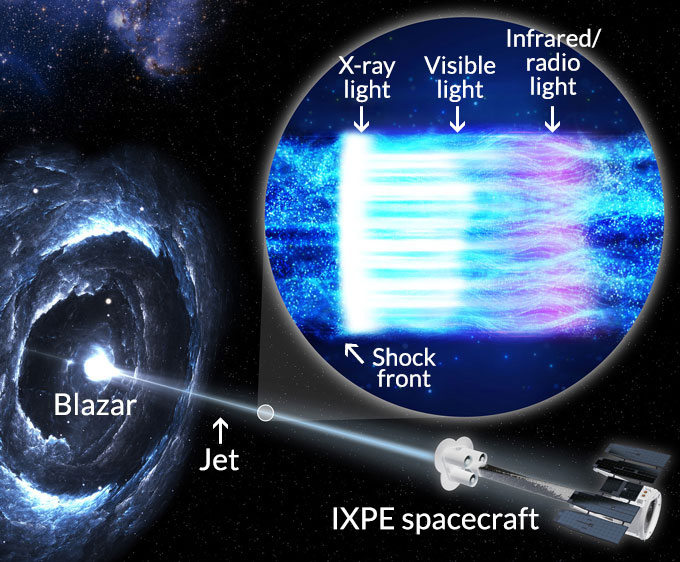Astronomers saw a telltale signature of shock waves shooting along a jet

Blazars (one illustrated) are active black holes that shoot jets of charged particles into space. New work shows how order and chaos in those jets can launch the particles.
For the first time, astronomers have observed how certain supermassive black holes launch jets of high-energy particles into space — and the process is shocking.
Shock waves propagating along the jet of one such blazar contort magnetic fields that accelerate escaping particles to nearly the speed of light, astronomers report November 23 in Nature. Studying such extreme acceleration can help probe fundamental physics questions that can’t be studied any other way.
Blazars are active black holes that shoot jets of high-energy particles toward Earth, making them appear as bright spots from millions or even billions of light-years away (SN: 7/14/15). Astronomers knew that the jets’ extreme speeds and tight columnated beams had something to do with the shape of magnetic fields around black holes, but the details were fuzzy.
Science News headlines, in your inbox
Headlines and summaries of the latest Science News articles, delivered to your email inbox every Thursday.
Enter the Imaging X-Ray Polarimetry Explorer, or IXPE, an orbiting telescope launched in December 2021. Its mission is to measure X-ray polarization, or how X-ray light is oriented as it travels through space. While previous blazar observations of polarized radio waves and optical light probed parts of jets days to years after they’d been accelerated, polarized X-rays can see into a blazar’s active core (SN: 3/24/21).
“In X-rays, you’re really looking at the heart of the particle acceleration,” says astrophysicist Yannis Liodakis of the University of Turku in Finland. “You’re really looking at the region where everything happens.”
In March 2022, IPXE looked at an especially bright blazar called Markarian 501, located about 450 million light-years from Earth.
Liodakis and colleagues had two main ideas for how magnetic fields might accelerate Markarian 501’s jet. Particles could be boosted by magnetic reconnection, where magnetic field lines break, reform and connect with other nearby lines. The same process accelerates plasma on the sun (SN: 11/14/19). If that was the particle acceleration engine, the polarization of light should be the same along the jet in all wavelengths, from radio waves to X-rays.
Another option is a shock wave shooting particles down the jet. At the site of the shock, the magnetic fields suddenly switch from turbulent to ordered. That switch could send particles zooming away, like water through the nozzle of a hose. As the particles leave the shock site, turbulence should take over again. If a shock was responsible for the acceleration, short wavelength X-rays should be more polarized than longer wavelength optical and radio light, as measured by other telescopes.
 The IXPE spacecraft (illustrated) observed polarized X-rays come from a blazar and its jet. The inset illustrates how particles in the jet hit a shock wave (white) and get boosted to extreme speeds, emitting high-energy X-ray light. As they lose energy, the particles emit lower energy light in visible, infrared and radio wavelengths (purple and blue), and the jet becomes more turbulent.PABLO GARCIA/MSFC/NASA
The IXPE spacecraft (illustrated) observed polarized X-rays come from a blazar and its jet. The inset illustrates how particles in the jet hit a shock wave (white) and get boosted to extreme speeds, emitting high-energy X-ray light. As they lose energy, the particles emit lower energy light in visible, infrared and radio wavelengths (purple and blue), and the jet becomes more turbulent.PABLO GARCIA/MSFC/NASA
That’s exactly what the researchers saw, Liodakis says. “We got a clear result,” he says, that favors the shock wave explanation.
There is still work to do to figure out the details of how the particles flow, says astrophysicist James Webb of Florida International University in Miami. For one, it’s not clear what would produce the shock. But “this is a step in the right direction,” he says. “It’s like opening a new window and looking at the object freshly, and we now see things we hadn’t seen before. It’s very exciting.”








